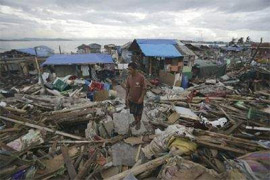Shelter is still a major issue in Philippines, two months after typhoon
By Chico Harlan, The Washington Post
5 January 2014
The typhoon that recently barreled through the Philippines has left in its wake one of the most profound resettlement crises in decades, with the number of newly homeless far exceeding the capacity of aid groups and the government to respond.
Two months after one of the strongest typhoons on record, recovery in the central Philippines has been marked by a desperate scramble for shelter, as people return to the same areas that were ravaged and construct weaker, leakier and sometimes rotting versions of their old homes.
|

In this photo taken on Dec. 7, 2013, a man stands among debris left by Typhoon Haiyan in Tacloban city, central Philippines.
|
That urgent but crude attempt to rebuild has raised the prospect that the storm-prone areas devastated by Typhoon Haiyan will emerge more vulnerable to future disasters. The self-made reconstruction effort also reflects the enormity of the damage. November’s catastrophe displaced more than 4 million people — twice the number of the 2004 Indian Ocean tsunami or the 2010 Haiti earthquake.
Left largely to fend for themselves, people are living in or under whatever remains. They inhabit boats or freight containers flung ashore by the tsunami-like storm surge.
For those who lose homes in a disaster, there’s almost never a quick solution, aid workers say.
What’s noteworthy in the Philippines, though, is not where people are resettling, but rather the degree to which they are staying put. Across the disaster zone, some 90 percent are still living in the same plot they were occupying before the typhoon.
Even if survivors wanted to go elsewhere, they have few options. The typhoon-hit region lacks formal evacuation shelters, and the first 1,000 government-built “bunkhouses” here don’t meet minimum international standards, according to aid workers.
Under ideal circumstances, the survivors would be rebuilding with new materials, not scraps, but help has been slow to arrive. Only 9 percent of those affected by the storm have received support for rebuilding.
Leyte Province, the area most directly hit by Haiyan, has so far received just 2 percent of the metal it needs for new roofs, Leyte Governor Dominic Petilla said in an interview.
“If only you gave people a better option, they’d take it,” Petilla said. “But we haven’t done that.”
Some aid workers say it’s almost commendable that the shantytowns have so quickly sprouted again. It’s what they call “self-rescue,” which you need on a disaster of this scale — at least on an emergency basis.
But viewed up close, the process looks more like peril than relief. In the waterfront slum neighborhoods of devastated Tacloban, Leyte’s largest city, a few survivors are living on the second floor of a building that scarcely has a first floor left. One family is living in a home slanted like a ramp, debris wedged under one side. Rolando Bagro, 45, lives with his wife and four children inside the two concrete walls of their home that were left standing after the storm.
His new roof includes a blue tarp, some sheet metal and an umbrella. Bagro’s wife and children now sleep together in a single room on a piece of plywood the size of a child’s bed. Bagro sleeps on a 3-foot-long bench he found after the storm.
“Every day is tiring,” Bagro said with a faint smile as he showed his home to a guest. “Because look how I sleep.”
The concern for officials locally and in Manila is that these re-sprouting slum neighborhoods will turn into permanent solutions for survivors. The officials have drawn up vague plans to eventually relocate entire coastal neighborhoods further inland, where they will be less prone to disaster, but the idea faces many obstacles, and would require the government to buy land, change laws and convince residents — many of them fishermen — to move to areas where they’d have to find new jobs.
Even in the best-case scenario, residents will likely remain in the flimsy rebuilt homes for many months or several years, said James Shepherd-Barron, a consultant for the International Federation of Red Cross and Red Crescent Societies, who is coordinating shelter relief in the Philippines. Meantime, it’s up to Manila and international aid groups to gradually deliver survivors better materials. Trained construction workers sent by NGOs will also tour the shanty areas, offering instructions about proper building techniques.
“Many [survivors] are not literate, so you’ve got to show them. You get amongst them, you give them drawings,” Shepherd-Barron said. “You tell them, If you build it this new way, your home will not fall down [during the next storm]. If you build it as your grandfather did, it will.”
Bagro lives on a flat spit of land forked by water. On one side, the San Juanico Strait, whose water surged on Nov. 8 through the city.
Already, residents here say, the neighborhood has made some progress. Nearly all of the corpses have been recovered by search teams with sniffing dogs. Though children have rashes and erupting welts, there have been no serious outbreaks of disease. A temporary cash-for-work cleanup program, run by Tzu Chi, a Buddhist humanitarian organization, sparked residents to clear roads of muck and debris. Bagro himself signed up for five days of the work, the maximum allowed. All told, he earned nearly $200, his only income since the storm.
He spent it on 18 beams of coconut lumber.
Not enough, but a start.

